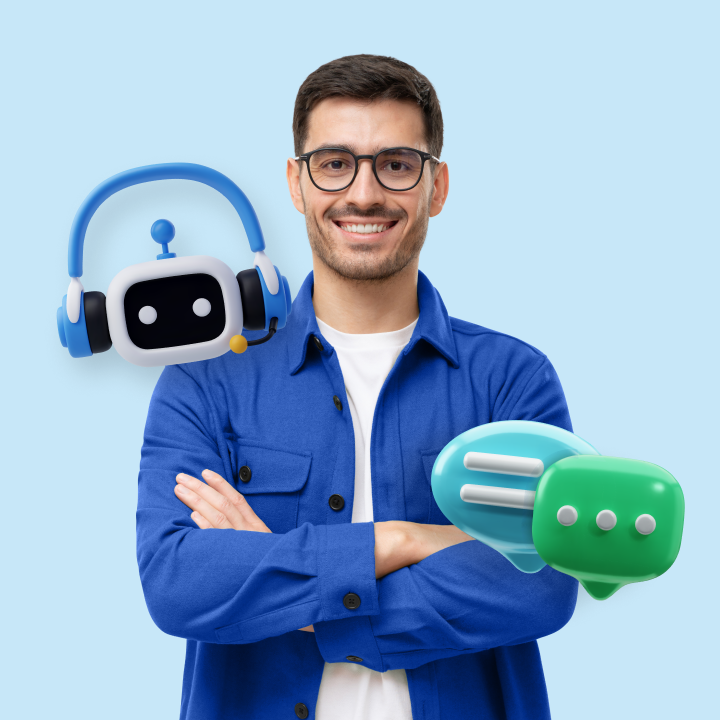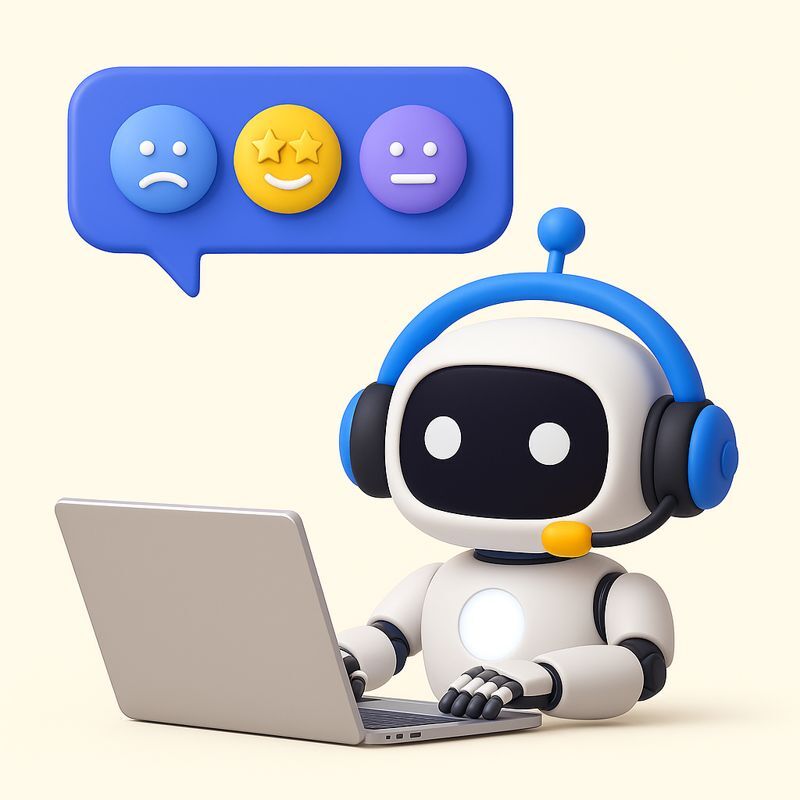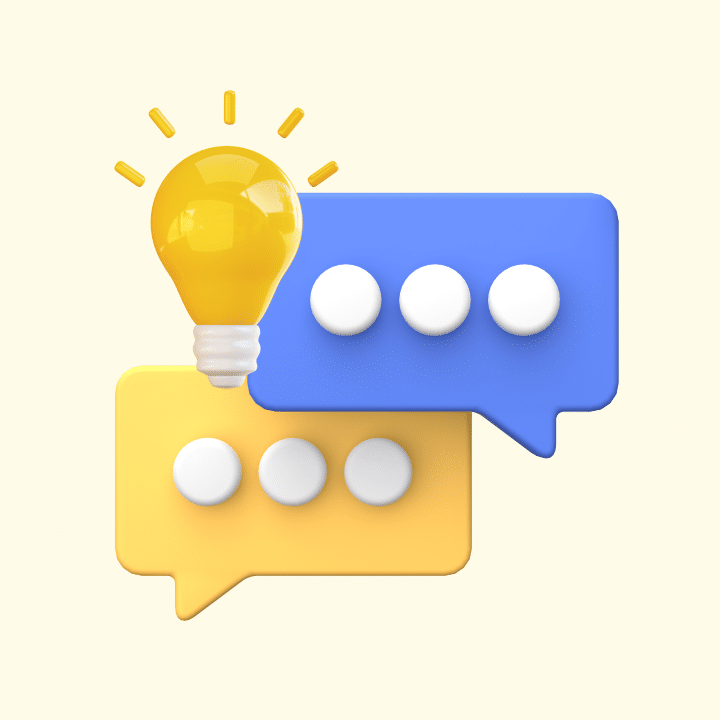Choosing between chatbot vs live chat comes down to trade-offs. Chatbots offer speed and scalability, handling routine questions instantly and around the clock. Live chat, on the other hand, brings the human touch: empathy, judgment, and personalized care when customers need it most.
So how do you decide which one fits your business best? That’s exactly what we’ll help you figure out.
In this article, we’ll break down the real differences between chatbots and live chat: their strengths, drawbacks, ideal use cases, and how leading businesses are combining both to deliver seamless customer experiences in 2025.
TL;DR
Chatbot vs live chat: Chatbots handle routine, repetitive queries 24/7 using AI; live chat connects customers to real agents for complex or emotional issues.
When to use chatbots: For FAQs, order tracking, or high-volume, low-complexity support.
When to use live chat: For troubleshooting, personalized advice, or situations that need empathy and human judgment.
Best approach: Use both—let chatbots manage simple requests and route tougher conversations to live agents.
Why it matters: Hybrid approaches reduce support costs, enable instant replies, and allow agents to focus on problem-solving. This results in higher customer satisfaction and loyalty.
What’s next? Seamless integration, more intelligent AI, and a focus on personalizing each customer journey, so no matter how people reach out, they get the right support, right away.
Table of Contents
- What Is The Difference Between A Chatbot and Live Chat?
- Pros and Cons of Using Chatbots Vs Live Chat
- How To Choose Between Chatbot Vs. Live Chat?
- When to Use Live Chat vs Chatbot vs Both in Customer Service?
- How to implement both chatbot and live chat?
- Chatbot vs Live chat: What’s the right solution?
- Frequently Asked Questions
What Is The Difference Between A Chatbot and Live Chat?
At first glance, both chatbots and live chat appear similar. They’re both chat windows on your website where customers can type questions and get answers. But that’s where the similarity ends. The fundamental difference lies in what’s behind that chat window.
A chatbot is software that imitates human conversation through text or voice interactions. These can be basic programs that follow scripts or advanced ones that understand and process natural language. It’s an intelligent assistant that can handle unlimited conversations simultaneously and provides instant responses 24/7. It is perfect for answering repetitive questions like “What are your shipping costs?” or “How do I reset my password?”
Live chat, on the other hand, connects customers directly with real people (customer support teams in most cases) through instant messaging. It is typically embedded within a website or mobile app, and enables users to ask questions, receive support, or engage with the company quickly and efficiently. Live chat is best when customers need personalized help, complex problem-solving, or empathy during difficult situations.
Pros and Cons of Using Chatbots Vs Live Chat
It’s hard not to get caught up in all the hype surrounding chatbots right now.
After all, these AI chatbots aren’t just answering FAQs anymore. They’re using natural language, learning from customer interactions, and helping teams manage spikes in support volume. In fact, businesses implementing AI chatbots achieve 30% cost reduction in contact centers.
But even with all the progress, chatbots also have some drawbacks associated with them.
Here’s a closer look at the pros and cons of using Chatbots:
| Pros ✅ | Cons ❌ |
|---|---|
| Available 24/7 without breaks, holidays, or time zones | Struggles with complex, nuanced, or multi-step problems |
| Instant responses (under 1 second) | Cannot detect emotions like frustration or urgency |
| Handles unlimited conversations simultaneously | Feels scripted or robotic for complicated queries |
| Scales effortlessly during traffic spikes | May frustrate customers when it doesn’t understand requests |
| Consistent answers every time | Limited ability to handle unexpected or unique situations |
| Automatic data collection and analytics | Upfront development costs and technical setup required |
| Perfect for repetitive FAQs and simple tasks | Poor at persuasion, negotiation, or relationship-building |
Nevertheless, the human side of support isn’t going anywhere. According to Hiver’s State of Customer Support Report, 63% of customers still turn to live chat when they really need help from another person.
Before you draw any conclusions for your own team, here’s a clear look at the pros and cons of live chat.
| Pros ✅ | Cons ❌ |
|---|---|
| Human empathy and emotional intelligence | Limited to business hours (unless you staff 24/7) |
| Handles complex, multi-layered problems with ease | Each agent handles only 2-3 conversations at once |
| Adapts tone and approach based on customer mood | Response times vary based on agent availability |
| Builds personal relationships and trust | Difficult to scale during peak periods without hiring |
| 2.8x higher conversion rates for sales interactions | Quality depends on individual agent skill and training |
| Can troubleshoot, upsell, and handle objections naturally | Requires ongoing training, management, and overhead costs |
| Provides rich qualitative insights from conversations | Agent turnover means constant re-training |
Recommended reading
How To Choose Between Chatbot Vs. Live Chat?
Here are a few key aspects to keep in mind as you decide which channel makes sense for your business:
1. 24/7 Availability
Chatbot > Live Chat
Chatbots are always on, since they don’t take any breaks or holidays. That means customers can get help any time, day or night, even on weekends. This is perfect for you if you need to support customers in every time zone.
Live chat, however, depends on when your agents are available. If you want true 24/7 support, it’s going to involve serious scheduling and extra costs for staff and training.
2. Speed of Response
Chatbot > Live chat
Customers hate waiting. So, prioritizing speed is essential.
For example, Decathlon, the world’s largest sporting goods retailer, was struggling with slow phone and email support for its massive customer base. When they switched to WhatsApp chatbots for initial customer contact, they reduced their average handling time by 50% while maintaining a 4.5-star customer satisfaction score.
Compare that to live chat: even with the best teams, the average live chat wait time is 35 seconds, according to Peak Support’s 2024 Customer Service KPI research. That might sound fast, but it depends entirely on how many people are chatting and whether agents are available.
3. Nature of queries
Another essential aspect to consider when deciding between a chatbot and live chat is the nature of customers’ queries.
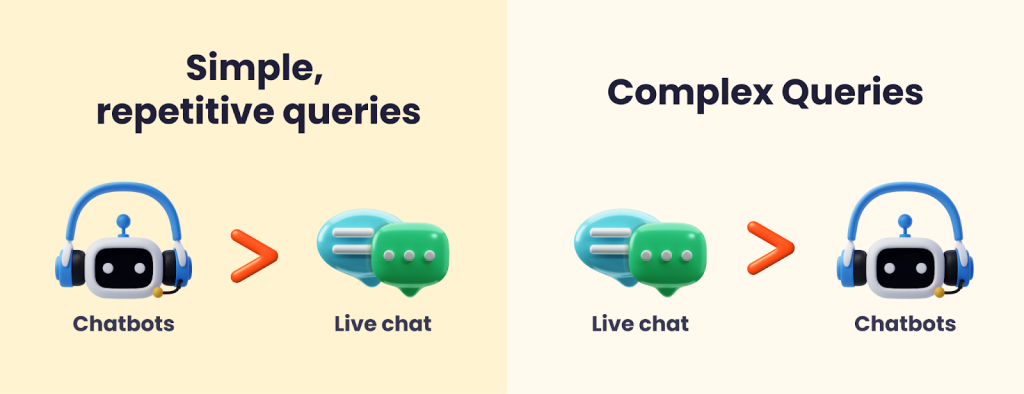
Chatbots are ideal if you receive many simple and repetitive queries. They can handle frequently asked questions well. For example, if you’re an e-commerce store, you can use a chatbot to answer common questions about order status, return policies, and product availability.
On the other hand, live chat suits more complex, nuanced, highly personalized queries that require human judgment and empathy. For example, if you run a boutique hotel, use a live chat widget on your website to handle unique guest requests, such as room preferences, special accommodations, and more.
4. Personalized Assistance
Live chat > chatbot
Only a human can give true personal service. Agents can ask extra questions, listen, and give advice based on what the customer truly needs. This is important when someone wants to feel heard, like during health issues or complex problems. In fact, 77% of customers won’t make a purchase if there’s no live chat support.
For example, in healthcare, it’s important to ensure that patients can talk to a real person on the other side when they seek support. Knowing someone is listening to you and is there to help makes a huge difference.
Chatbots simply can’t replicate this. They can’t detect worry in a patient’s tone and offer genuine reassurance. These moments require human empathy, not programmed responses.
5. Cost-Effectiveness
Chatbot > Live chat
Did you know businesses can save up to 30% on customer service costs by implementing chatbots? This is due to reduced dependency on human support staff and lower operational expenses.
Here’s why chatbots are more cost-effective:
- No Salaries or Benefits: Chatbots do not require salaries, benefits, or other employment-related expenses such as health insurance, paid leave, and retirement contributions.
- Cost Per Interaction: A study by Chatbots Magazine found that the cost per interaction using a chatbot is lower than using human support reps. A chatbot interaction costs around $0.70, compared to $6-$12 for an agent-handled interaction.
- Reduced Training Costs: Unlike humans, chatbots don’t need extensive training or continuous professional development.
- Infrastructure Savings: Chatbots reduce the need for extensive office space and associated infrastructure.
Live chat, on the other hand, comes with ongoing expenses that add up quickly. The average customer service representative salary in the U.S. is $31,549 annually ($15.17/hour). Factor in benefits and recruiting expenses, and each live chat agent costs a business significantly more than chatbot software subscriptions.
6. Integration with other apps
Chatbot = Live chat
Both chatbots and live chat connect easily with your CRM, help desk, or analytics tools, so customer data flows smoothly no matter who handles the conversation.
The difference lies in how they use that data.
A chatbot can instantly pull updates like shipping status or account details and share them with the customer within seconds. It’s great for speed and consistency.
A live agent uses the same data to empathize and make thoughtful decisions. They might offer a replacement for a delayed order or add a goodwill discount when needed.
In short, integrations empower both tools equally. Chatbots deliver instant accuracy, while humans turn information into meaningful connections.
7. Ease of use
Chatbot = Live Chat
Setting up both channels is extremely easy.
Both chatbot platforms and live chat use a chat window embedded on your website or within your app. Customers type their messages and receive responses in this window.
Most chatbot builders and live chat software offer no-code solutions. This means you can deploy them without any programming knowledge. The software handles the technical setup automatically. You just customize the chat widget, set your preferences, and add it to your site.
8. Scalability
Chatbot > Live Chat
Chatbots are easiest to scale.
Think of it this way: if you suddenly get 500 customer questions instead of 50, a chatbot handles all of them at once without breaking a sweat. There’s no extra cost per conversation, and you don’t need to worry about hiring or training anyone new.
Even better, if you need to update information like new product details or policy changes, you make the change once, and every chatbot conversation reflects it instantly.
Live chat is different. Each agent can only handle 2-3 conversations at once. So if your customer volume doubles, you need to hire more people, train them, manage schedules, and deal with all the costs that come with a bigger team. Scaling live chat means scaling your entire support operation, which takes time and money.
This is why chatbots are often the go-to choice for businesses that expect rapid growth or seasonal spikes in customer inquiries.
9. Sales and Upselling Opportunities
Live Chat > Chatbot
When it comes to making sales, live chat beats chatbots hands down. In fact, Forrester research says that customers who engage with a company’s live chat are 2.8 times more likely to convert than those who do not.
For example, a chatbot can only give pre-written answers when someone’s on the fence about buying. But a live agent can listen, understand the customer’s needs, and suggest the right products. They can say things like “Based on what you told me, this model might work better for you” or “A lot of customers also get this accessory with that item.”
Companies like Zappos and Dell have mastered this. For instance:
- Zappos is known for its excellent customer service. Their agents don’t just answer questions; they build relationships and naturally suggest upgrades or add-ons that actually help the customer.
- Dell uses live chat to assist customers with product choices and to provide technical support. This interaction often leads to upselling opportunities like additional accessories based on the customer’s needs.
10. Improve Customer satisfaction
Chatbot = Live chat
Chatbots excel at keeping customers happy through speed and availability. When customers need quick answers to simple questions like checking order status or store hours, instant responses make all the difference.
Live chat platforms shine by delivering personalized, empathetic support. When customers face complicated issues or feel frustrated, talking to a real person who listens and genuinely cares creates loyalty.
So both chatbots and live chat can positively impact your customer satisfaction scores, but in different ways.
Some companies are hitting home runs by using both. Domino’s launched their chatbot Dom on Facebook Messenger, which has handled over 1.5 million conversations and saved them $500,000 in live agent costs. But they didn’t abandon human support—Dom smoothly hands over complex orders or complaints to real agents.
Tidio is another great example. Their AI chatbot Lyro handles about 70% of customer conversations on its own, but when things get tricky, it passes customers to live agents without missing a beat. Companies using this setup report that the AI handles routine stuff fast, while humans focus on the complex problems that actually need personal attention.
11. Insights into customer behavior
Chatbot = Live Chat
Understanding what your customers need, what frustrates them, and where they get stuck is crucial for improving your service. Both chatbots and live chat platforms collect valuable conversation data that reveals patterns in customer behavior.
Zalando is a perfect example of this. Their AI shopping assistant not only handles customer questions but also tracks what people are looking for. This data helped them see a 23% increase in product clicks and a 40% boost in wishlist additions. They used the chatbot insights to understand fashion trends and improve their product recommendations.
Similarly, Camping World’s live chat analytics showed them which questions came up most often, so they trained their chatbot “Arvee” to handle those first. The result? 40% higher customer engagement and 33% shorter wait times because human agents could focus on complex issues while the bot handled routine stuff.
And then there are companies that are using both to understand more about the customer experience. For instance, OPPO uses chatbot data to spot patterns (like common complaints) and live chat sentiment analysis to understand how customers feel about solutions. This dual approach helped them achieve a 57% boost in repurchase rates while maintaining 94% positive feedback from customers who did talk to humans.
When to Use Live Chat vs Chatbot vs Both in Customer Service?
Deciding between chatbots and live chat isn’t really about picking sides; it’s about finding the right teammate for each part of your customer journey. Here are a few scenarios to help you decide
Go with live chat when:
- Your customers need emotional support, not just information: Think about the last time you called your bank about a fraudulent charge on your account. You weren’t just looking for facts; you wanted reassurance, understanding, and someone to walk you through the next steps. When customers are stressed, confused, or dealing with sensitive issues, a real person who can say “I understand how frustrating this must be” makes all the difference.
- Your product decisions require back-and-forth conversation. Sometimes, a product needs a detailed explanation, demonstration of value, and reassurance that it’s the right fit. For example, if you’re selling enterprise software that costs $1000 per year, these aren’t impulse purchases; they’re investments that need explanation, customization, and trust-building.
- Complex problems need human judgment: When a customer says, “My integration with Salesforce isn’t syncing properly after this latest update,” they’re not looking for a scripted response. They need someone who can ask follow-up questions, understand their specific setup, and maybe even do screen sharing to diagnose the issue. These multi-layered problems require the kind of flexible thinking and troubleshooting that humans excel at.
Stick with chatbots when:
- Volume is overwhelming your human team: When customer inquiries suddenly spike, hiring and training enough agents to keep up simply isn’t realistic. It takes weeks to recruit, onboard, and train new support staff. Chatbots solve this by handling the high-volume, straightforward requests instantly, allowing your human agents to focus on the conversations that actually need their expertise.
For example, Sunbasket doubled its customer base during the pandemic, and its support volume exploded. So instead of hiring dozens of new agents overnight, they used their existing Einstein chatbot to handle the flood of “Where’s my order?” and “I’m missing an ingredient” messages. This freed up human agents to focus on complex issues like dietary restrictions and subscription changes.
- You get a lot of predictable questions: If you’re running an e-commerce store and 80% of your tickets are about shipping times, return policies, or order status, you’re wasting human talent on repetitive work. Chatbots can resolve those queries without burning out your staff.
- Your business operates across time zones: Sometimes you can’t afford to staff support teams in multiple countries, but customers expect help when they need it. A chatbot never sleeps, never takes a vacation, and handles a customer in Tokyo at 3 AM just as efficiently as someone in New York at 3 PM. Chatbots offer significantly better long-term cost efficiency for businesses watching their budget, especially as they scale.
Use both when:
- You want to filter complexity intelligently: Think about how many different types of conversations happen on your website every day. Some visitors just want quick facts like business hours, pricing, and shipping info. Others have layered questions that require back-and-forth discussion, like comparing multiple products or troubleshooting technical issues. A smart hybrid system acts like an intelligent receptionist, instantly handling the straightforward stuff while recognizing when a conversation needs human expertise.
- Customer expectations vary wildly within your audience: Some customers want to self-serve and get out quickly. Others want personalized advice. Instead of forcing everyone down the same path, let chatbots serve the speed-seekers while live agents focus on relationship-builders.
- Your business is scaling rapidly, but quality matters: Growth often translates to hiring more staff. A hybrid approach solves this dilemma by maximizing your existing team’s impact.
For instance, Fantastic Services saw its chat ROI increase by 100% by using Freshchat’s intelligent routing. The chatbot greets every visitor, understands whether they need sales or support, and routes them to the right person immediately. No more “let me transfer you” conversations. Customers get to the right expert from the start.
How to implement both chatbot and live chat?
If you’re looking to add both live chat and a chatbot to your website, using a customer service platform that offers these features is the easiest way to go. Hiver is one such platform. It’s an AI customer service platform that lets you manage live chat, chatbot, email, and more, all from a single, intuitive interface. You don’t need any technical skills, and you can get started for free.
Setting up Live Chat
Getting live chat up and running with Hiver is quick and beginner-friendly. Here’s how you do it:
Step 1: Install Hiver and Sign Up
- Go to the Hiver website and sign up for a free account.

Step 2: Create Your Live Chat Inbox
- Head to “Hiver Settings” and open the “Admin Panel.”
- Click “Create Shared Inbox” and choose “Hiver Chat” as your channel.
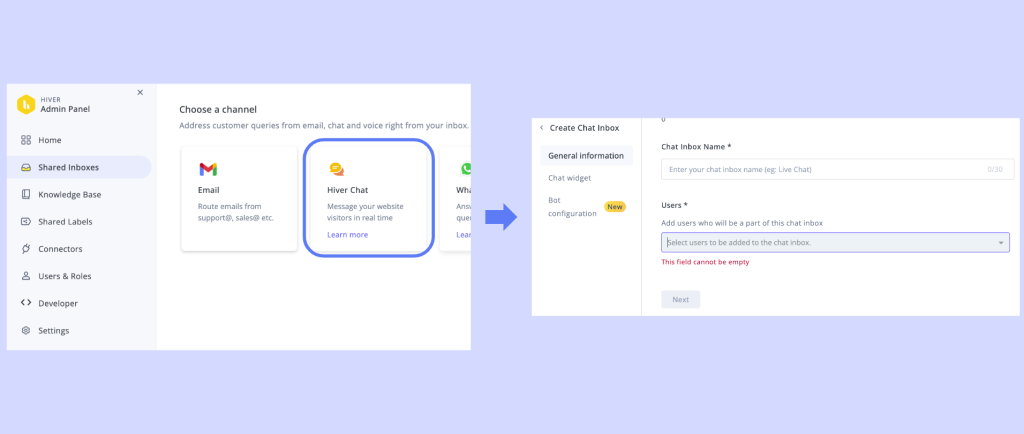
Step 3: Configure Your Team and Widget
- Name your chat inbox for your team’s reference.
- Add users who will manage chats, or invite new teammates via email.
- Click “Next” to design your chat widget and preview the look.
- Personalize further with a name and avatar for your live chat assistant.
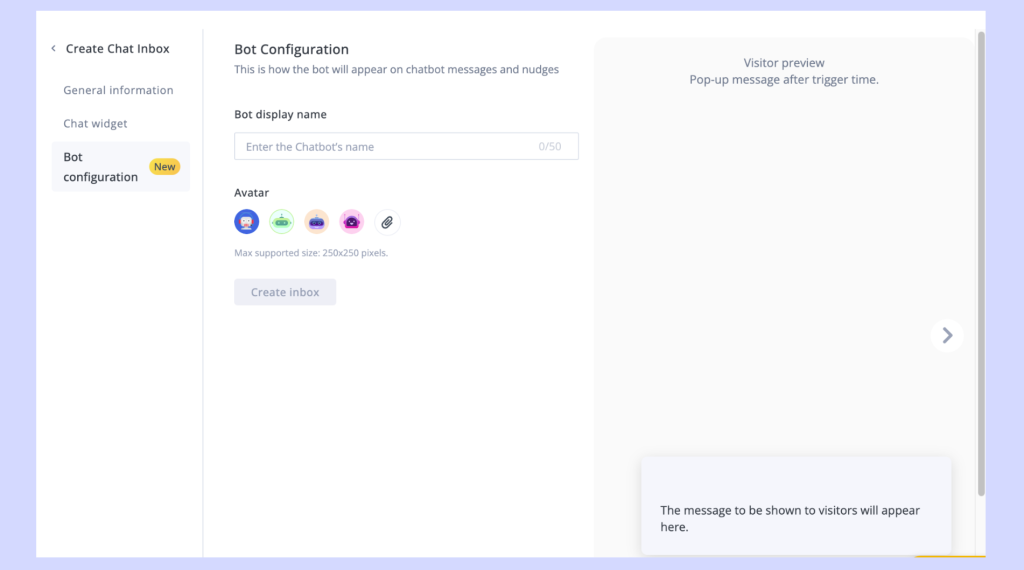
Step 4: Finalize and Go Live
- Click “Create Inbox” to launch.
- If you need to, add the installation code to your website (or, if you’re using a common platform, integrations may handle this automatically).
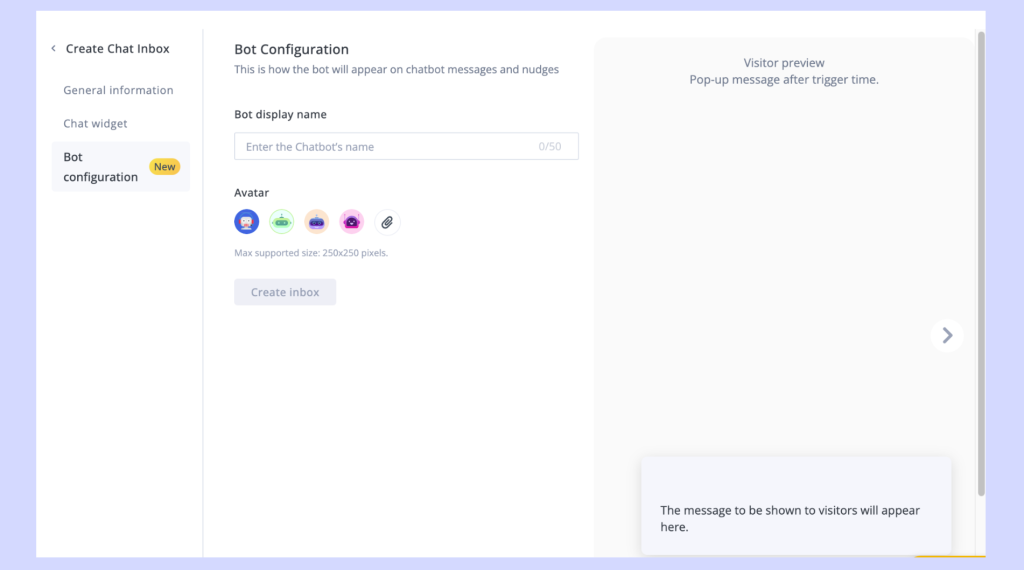
Setting up Chatbot
Before building your chatbot, make sure you’ve already set up your live chat inbox and widget on your website. The chatbot works through your live chat widget, so it needs to be active first.
Step 1: Open the Chatbot Admin Panel
- Go to your Hiver dashboard, navigate to the Admin panel.
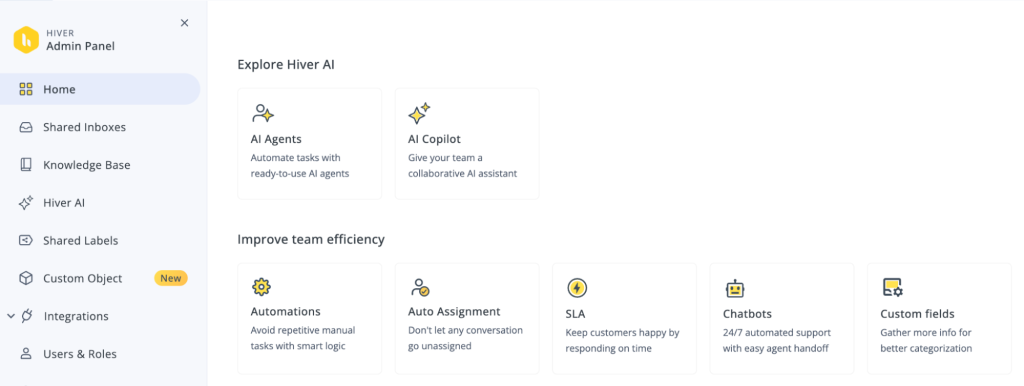
Step 2: Select “Chatbots”
- Under the “Improve team efficiency” section, click on Chatbots.
- Pick the chat inbox where you want the chatbot to run.
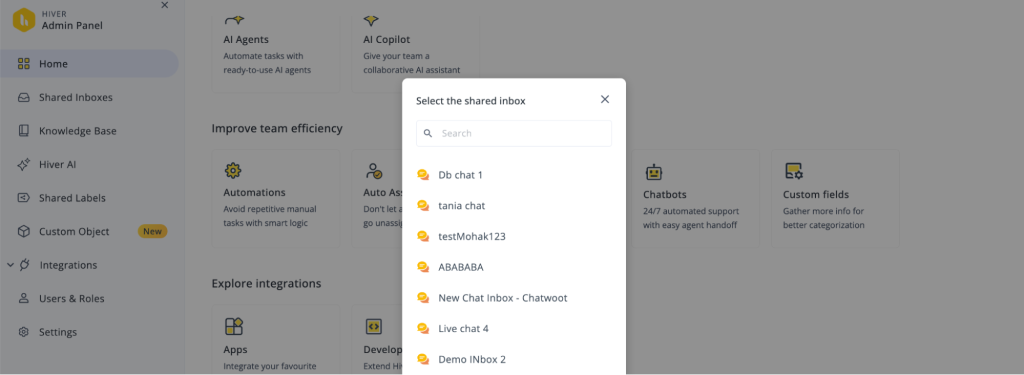
Step 3: Set up Your Bot’s Identity
- In the Bot Configurations tab, give your bot a name.
- This is the name users will see in the chat widget.

Step 4: Create a New Chat Flow
- Click Create new chat flow in the top-right corner.

Step 5: Name Your Chat Flow
- Enter a name for your flow and click Next.
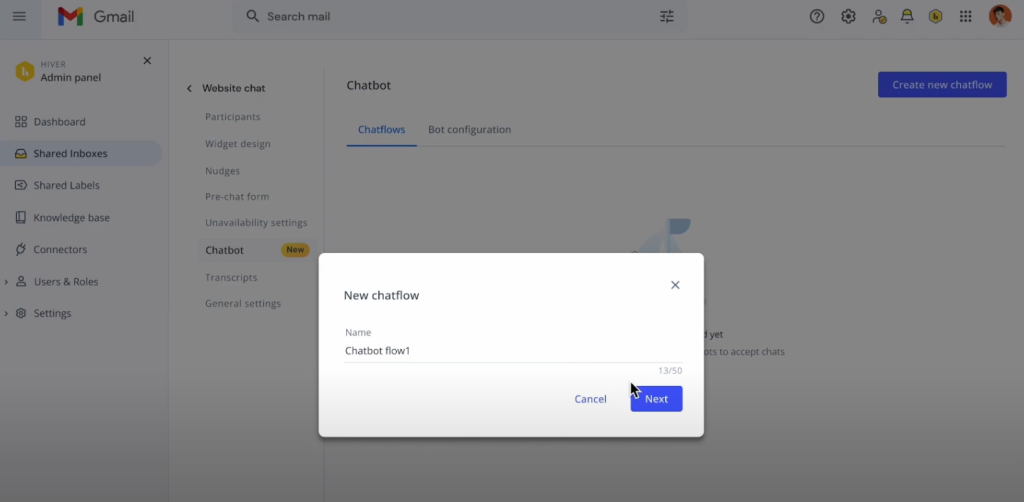
Step 6: Choose a Starting Event
- Choose what triggers the chatbot (e.g., user clicks the chat bubble).
- Click Next to continue.
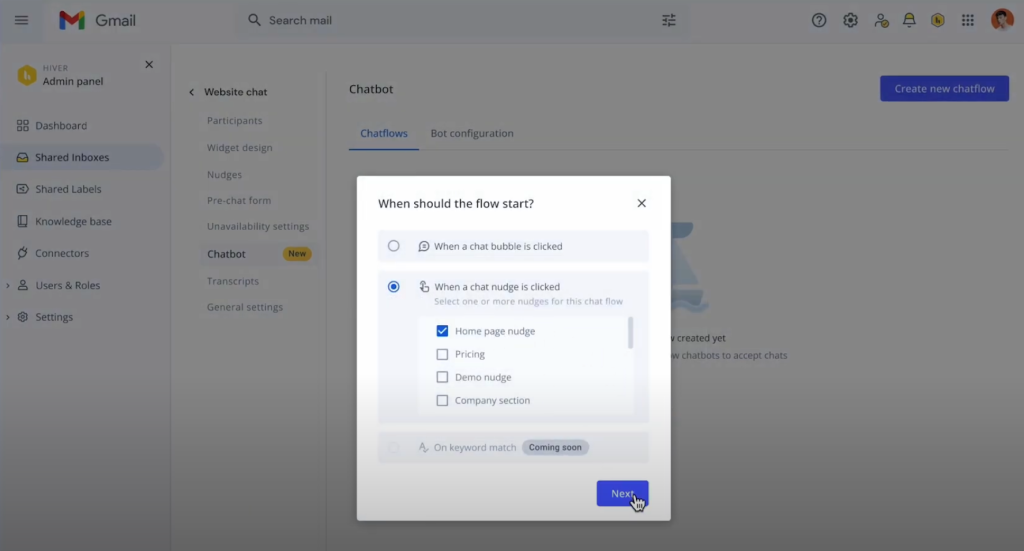
Step 7: Build Your Conversation Flow
- The chatflow builder will open.
- Use blocks (messages, questions, actions, agent handoff, etc.) to design the conversation.
- If you need ideas, Hiver provides a sample flow video and a guide to chatbot blocks.
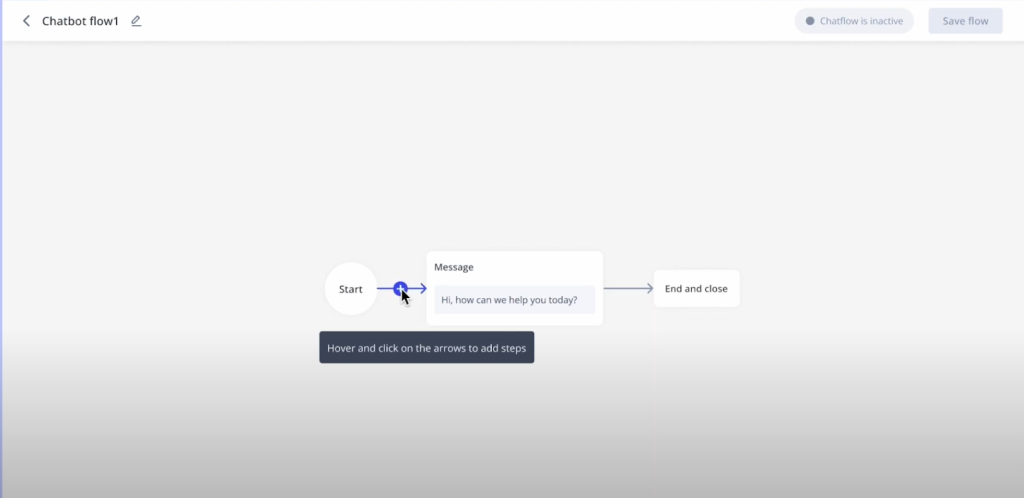
Step 8: Save and Review
- Once your flow is ready, click Save.
- You’ll see your new chat flow in the Chatflows tab.

Step 9: Activate Your Chatbot
- Toggle your chat flow to active so it starts handling real conversations on your website.
Chatbot vs Live chat: What’s the right solution?
Customer expectations in 2025 are higher than ever. They want speed, accuracy, and empathy all at once. That’s why the smartest businesses aren’t choosing between chatbots and live chat; they’re integrating both.
Combining automation with human expertise gives you the best of both worlds: fast responses for simple queries and thoughtful conversations when customers need real care.
Platforms like Hiver make it easy to do exactly that. You can manage live chat, chatbots, email, and analytics in one place so your team can deliver consistently great experiences without extra tools or complexity.
Frequently Asked Questions
1. What is a chatbot?
A chatbot is a computer program that simulates conversation with humans. It uses artificial intelligence and natural language processing to answer questions, provide information, and help with tasks like tracking orders or explaining company policies. Chatbots work right from your website, messaging app, or helpdesk, and are available any time, day or night.
2. What is live chat?
Live chat is a way for customers to talk directly with a real person on a website or app. Unlike chatbots, live chat connects users to human support agents for real-time help with questions, troubleshooting, or personalized advice.
3. Which is better between Chatbot and Live Chat?
Neither one is better in every situation. Chatbots are faster, cost-efficient, and available 24/7, while live chat provides empathy, emotional understanding, and human judgment. The best customer service teams in 2025 use both chatbots for quick, repetitive queries and live chat for complex or sensitive cases.
4. When should live chat be used in customer service?
Use live chat whenever customers face complex issues, need quick, personalized help, or when empathy and troubleshooting are important. It’s ideal for multi-step problems and sensitive topics.
Start using Hiver today
- Collaborate with ease
- Manage high email volume
- Leverage AI for stellar service
 Skip to content
Skip to content



